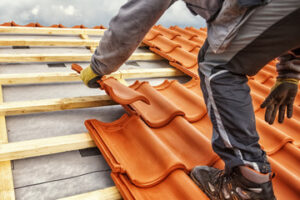Air conditioning systems are much more than machines that blow cold air. They regulate temperature and humidity to provide a comfortable home environment, which can save money on energy bills.

Problems with these systems can also have serious health repercussions, particularly in elderly or young children. A poorly functioning AC can cause heat exhaustion or even death in extreme temperatures. Contact AC Repair Round Rock TX for professional help.
The compressor is the heart of an air conditioning system. Without it, the rest of the system would not work. The compressor takes in refrigerant, compresses it, and distributes it throughout the system. Cool air is produced when the compressor transfers heat from the refrigerant to the home’s air. A broken compressor halts all cooling.
Signs of a failing compressor include the obvious, such as warm air coming out of your vents. However, you should watch out for more nuanced signs as well. For example, if the compressor clutch doesn’t engage, it could be an indicator that it is overheating or that it has locked up. This is a serious problem that requires professional AC repair.
In some cases, the compressor fails because it has worn out or because it is not functioning as intended. The best way to prevent this from happening is to have a technician perform regular preventative maintenance on the compressor. This will help ensure that the compressor is in good working condition and that the underlying problems are corrected before they have a chance to damage it.
Another common cause of a compressor failure is improper installation. In some cases, technicians install suction lines that are too long or too short and create pressure build up in the system that eventually damages the compressor. In other instances, the compressor is damaged by burnt wires. This occurs when the wires become so hot that they char or completely burn. If the wires are exposed, they will short to ground and draw current that will destroy the compressor.
A burning smell or a loud popping noise should also signal that it is time to call for professional AC repair. If you keep having to reset your circuit breaker, it may be because the compressor is drawing too much power. This is a serious issue that should not be ignored, and the technician should evaluate whether the compressor needs to be replaced or repaired.
It is important to remember that a failed compressor can be repaired only if the technician is able to restore it to its original factory specifications. This is not always possible, and in some cases, it makes more sense to replace the entire air conditioning unit.
Dirty or Clogged Condenser Coil
The air conditioner’s evaporator coil, located indoors, absorbs heat from the circulating home air. The hot air then passes through the condenser coil, where it releases the heat to the outdoor environment via refrigerant. The coils must stay clean to ensure the proper transfer of heat and maintain optimal AC performance.
If your AC system isn’t cooling your home evenly, if rooms are getting warmer than others, or if you’ve noticed a recent increase in your electricity bill, these could be warning signs of clogged coils. Organic debris like leaves, plant blooms, pollen, cottonwood seeds, and dust can quickly coat the coil fins. The resulting insulation limits heat absorption and causes the system to work harder to cool the home.
Dirty or clogged coils require professional cleaning to restore efficient performance and extend the lifespan of the system. Scheduled preventative maintenance can help reduce the need for frequent coil cleanings, but it’s also a good idea to perform a quick visual inspection monthly. Keep in mind that environmental factors influence how frequently you need to inspect and clean the coils, with annual or bi-annual deep cleanings typically recommended by most technicians.
Performing a basic coil cleaning isn’t complicated. Before you start, however, make sure the unit is turned off and that the power cord is removed. If your unit has a grille or cover over the fan, remove it to allow for better access. Next, unscrew the screws that hold the fan and motor assembly in place. Bag the screws and set them safely aside. Finally, use a cordless drill or screwdriver to unsnap the wiring harness from the fan assembly to free it completely.
Now you can access the coils themselves. Start by removing any dirt, dust, or twigs that are sticking out from the fins. Use a nylon scrub brush to gently dislodge any larger chunks of buildup, being careful not to damage the coils. If there is any remaining dirt or debris, spray the coils with a garden hose to dislodge it. Once the coils are clean, reassemble the system and turn it on to test for proper function.
Dirty or Clogged Drain Line
The air conditioner drain line is a critical component of your home’s cooling system. It connects the indoor air conditioning unit to the outdoor unit and is responsible for transporting condensation away from the evaporator coils. When this line becomes dirty or clogged, excessive moisture may accumulate in and around your indoor air conditioning unit. This moisture can result in water damage, mold growth and reduced cooling efficiency.
The first step to resolving a clogged AC drain line is to shut off power to the air conditioner. Locate the electrical disconnect switch, usually located near the outdoor unit and flip the switch to the off position. This will prevent any accidents or shocks while you work on the AC.
Next, find the AC drain line and locate its clean-out plug. This is a large drain pipe that is typically found in an area such as your basement, crawlspace, garage or near the foundation of your home. Remove the plug using a wrench. Once the plug is removed, place a bucket underneath to catch any wastewater that may drain out during the cleaning process.
Once the AC drain line has been cleaned and flushed, it’s important to test its functionality. Pour a cup of water into the drain line and observe if it is flowing freely. Once the water is clear, the line is functioning properly and can be considered cleared of clogs.
To help prevent future clogs in the AC drain line, consider investing in high-quality HVAC filters that are designed to trap debris and keep it from entering the air conditioning unit. Regularly changing the filters can help prevent dust from building up and causing blockages in the drain line.
If your clogged AC drain line isn’t responding to vinegar, you can call an HVAC technician for assistance. Licensed technicians often have specialized tools and equipment to remove stubborn clogs without damaging the drain line or your air conditioner. They can also address underlying issues and provide routine maintenance to prevent future clogs. An AC technician will be able to assess your home’s needs and recommend the right type of solution for your air conditioner.

